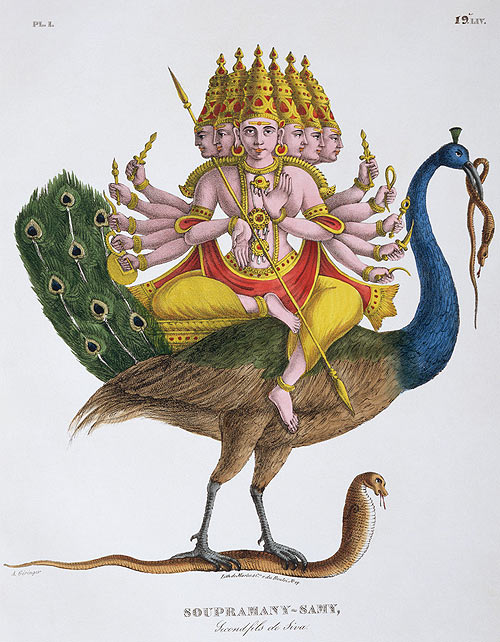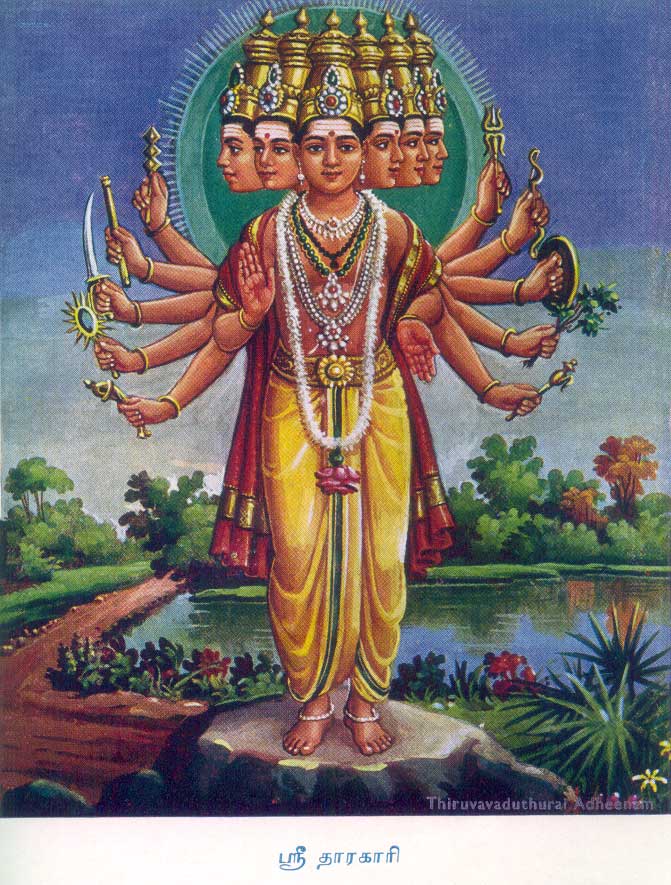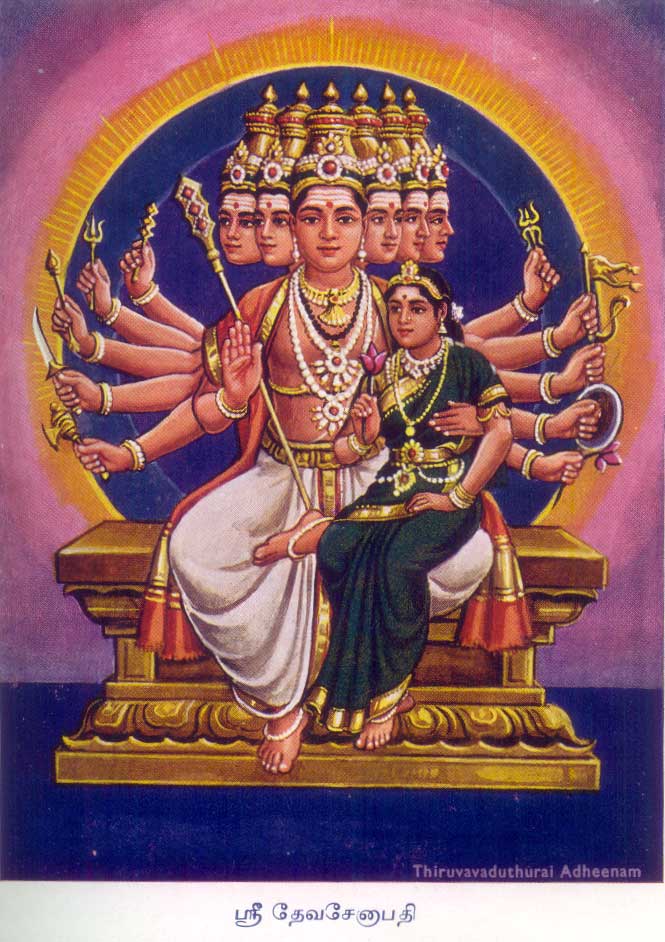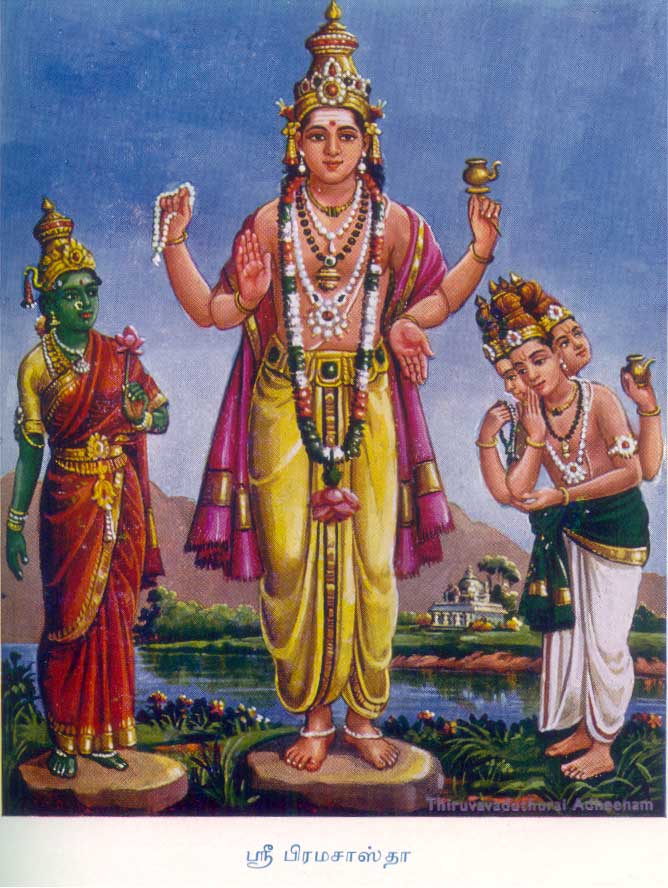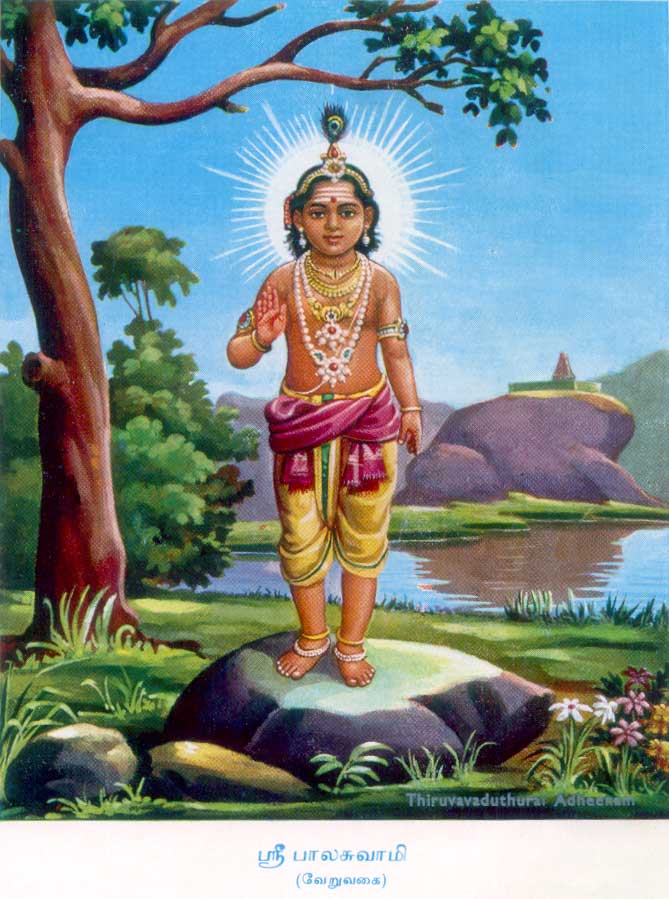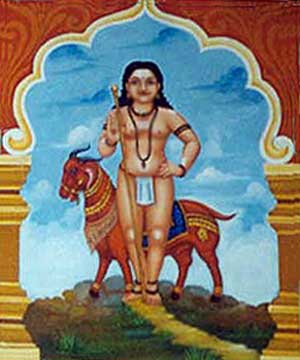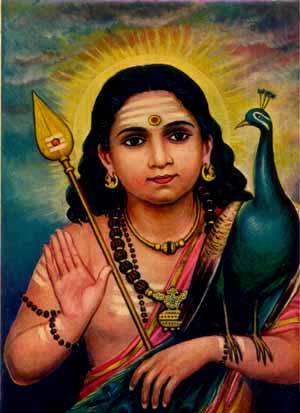
|
|||||||||||||||||
|
| |||||||||||||||||
Aspects of Kārttikeya's CharacterChapter Seven of The Cult of Skanda-Karttikeya in Ancient India by Asim Kumar Chatterjee, pp. 98-111
Contents
It is difficult to find a more complex deity in the Brahmanical pantheon than Skanda-Kārttikeya. His most well-known portfolio is that of the Commander-in-Chief of the celestials; but he also appears as a mahayogi and a patron of learning. He is depicted, elsewhere, as a god worshipped by the thieves and robbers and a god of amorous love, a malignant god harassing children and new-born babes. Some other outlandish traits are also found in his character. In this chapter we will endeavour to make an exhaustive survey of his various characteristics. Skanda as a god of warIn the Upanisads and the sutra literature Skanda does not appear as a war-god, although the name Mahasena, as has been noticed before, is not absent in the latest Vedic literature. In the Great Epic, however, he is repeatedly described as the general of the gods. In the Rg Veda both Indra and Agni are pictured as warrior-gods, as the gods leading the Aryans in their wars against the Dasas and the Dasyus. Indra's well-known epithet 'Purandara' (destroyer of the Puras) can have only one meaning. Again the Fire-god, as we have previously remarked, was also conceived as a war-god. In the Great Epic, however, his son replaces him as the generalissimo of the gods. From the Vanaparvan account it becomes clear that Skanda won this title only after humbling the pride of the mighty lord of the gods, Devaraja Indra. This event is narrated in chapter 227 of the Vanaparvan where Karttikeya's war with Indra and other celestials has been vividly described. This event is also referred to in some other Puranas. He grew so powerful that he was requested by the Rsis and others to become 'Indra' of the three worlds; but as Skanda had no fancy for Indraship, he allowed Sakra to retain his title. Karttikeya's greatest achievement as the generalissimo of the gods was his killing of the demons Mahisa and Taraka. The killing of Mahisa is described in some details in the Vanaparvan account of Skanda's birth and exploits. This event is also referred to in the Salyaparvan,[1] Visnudharmottara[2] and Vamana Puranas.[3] In the Brahmanda Purana[4] also Skanda is described as Mahisasuranarinam nayananjana-taskaram. Now, as we all know, the famous Devi-Mahatmya of the Markandeya Purana has described in great details Durga's war with Mahisa in which the latter was ultimately defeated and killed. This event is also indirectly mentioned in the Matsya Purana.[5] The Brahmanda Purana also supports the account or the Devi-Mahatmya.[6] Some early sculptures, dating from the beginning of the Christian era, represent Durga as destroying Mahisasura.[7] The earliest representation of Mahisasura-mardini, found so far, is probably a terracotta plaque from Nagar, Rajasthan,[8] which has been assigned to the first century B.C.
Notwithstanding all these evidences, there is nothing to disprove that the story of Durga's killing of Mahisa was not borrowed from some earlier accounts. We have already pointed out that the Vanaparvan account, which narrates Skanda's war with Mahisa, was certainly composed before the Christian era. In the list of Skanda's names, found in the 232nd chapter of the Vanaparvan, we have the significant name Mahisardana. It is also interesting to note that in the later accounts of Skanda's exploits, the killing of Mahisa is rarely referred to. There cannot be any doubt that in the later period the account of Karttikeya's killing of Mahisa was nearly forgotten and replaced by the Durga-Mahisasura story; yet the former account was not entirely thrown into oblivion as is proved by the references in the Brahmanda, Visnu-dharmottara and Vamana Puranas. It is reasonable, therefore, to infer that the story of Durga's killing of Mahisasura was borrowed from the source indicated above. It should be noted in this connection that the epithet Mahisasuramardini is absent in the Durgastotra preserved in the Bhismaparvan (Ch. 23) of the Great Epic; in the hymn sung by Yudhisthira in the Virataparvan (Ch. 6) we, however, get the title 'Mahisasuranasini', but this stotra is not found in the Southern recension of the Mahabharata. It is not illogical, therefore, to conclude that the Great Epic, as a whole, contains no reference to Durga's Mahisasuramardini aspect. As a matter of fact, as R.G. Bhandarkar points out, both the Durga stotras are later intrusions into the Great Epic.[9] The story of Karttikeya's killing of Taraka is, of course, much better known. The earlier Vanaparvan account (chs. 222-32) is expressly silent on this point. It is, however, indicated in the Salya account and confirmed by the Anusana story of Karttikeya's birth and exploits. We will not be far wrong in believing that the Taraka episode is a later addition to the Karttikeya-mythology. The earliest sculpture of Tarakari Skanda cannot be dated before the sixth century A.D. (see also ch. VIII). It should also be noted that the Great Epic nowhere gives any detailed account of Skanda's war with Taraka. The Visnu Purana does not mention him while the Vayu refers to his name only once. It is in the somewhat later Puranas like the Matsya,[10] Padma,[11] Skanda[12] and others that we get a detailed account of Skanda's war with Taraka. In any case, we should be prepared to believe that the Taraka-episode is distinctly later than the Mahisa-episode. It must also be remembered, in this connection, that the name Tarakari is conspicious by its absence in both the Vanaparvan and Skanda Purana lists of Skanda's names. Karttikeya's title Devasenapati has two meanings, viz. the general of the army of celestials and the husband of Devasena. The latter, according to the Vanaparvan (chapter 222), was a daughter of Prajapati, who was rescued by Indra from the clutch of a demon named Kesin and later given in marriage to Skanda. As a warrior-god Skanda reminds us of the Greek Ares and the Roman Mars. Yet, as Goodwin[13] points out, "there is an essential difference between the Indian conception of Skanda and that of the Classical mythology, especially in the absence of that heaviness, that brute force unrelieved by lighter and more vivacious qualities, which characterize the war-gods of the Greeks and Romans. In Mars, we expect only prodigious strength, a mighty and crushing blow, not any exhibition of quick dexterity or mercurial cunning." The Indian War-god is not only powerful but his personal beauty is often alluded to. He rides on the peacock which is the most beautiful bird found anywhere in the world. As a war-god Skanda's most characteristic weapon is sakti or lance. This sakti, according to the Visnu[14] and Markandeya[15], was fashioned by Visvakarman for Skanda from the solar energy.[16] Skanda as a god of learning and wisdomKarttikeya is not only a great warrior but he is acclaimed in various places as the god of wisdom and learning. This conception is probably due to his connection with the Vedic sage Sanatkumara. In the Chandogya passage, quoted before, he is identified with that sage. This identification of Skanda with Sanatkumara is confirmed by another passage in the 46th chapter of the Salyaparvan.[17] According to both the Vayu[18] and Brahmanda[19] Skanda and Sanatkumara are the sons of Agni by Svaha. In the Great Epic the title Yogisvara has been conferred on him more than once.[20] He also receives the epithets Brahmanya, Brahmesaya and Brahmanistha. We are also told that he is the foremost of those who are possessed of Brahman.[21] The Puranas explicitly connect him with wisdom and learning. According to the Kurma Purana, he is an authority on Brahmavidya: yo'pi Brahmavidyayam. 'srestho devasenapatih prabhuh.[22] The Milindapanha, which was not improbably composed before the beginning of the Christian era, informs us that the god Mahasena (i.e. Skanda-Karttikeya) was born as Nagasena (the guru of king Milinda or Menander) at the request of Sakka (i.e Indra). There He is represented as a 'most wise' god who is able to hold conversation with Milinda and to resolve his doubts.[23] The evidence of this well-known non-Brahmanical work is of the highest importance. It proves that from a fairly early period there was a distinct tradition which connected Skanda-Karttikeya with wisdom and learning. According to the Skanda Purana, even Mahadeva had to acknowledge Skanda's superiority: Matto'pi jnanayogena Skando'pyadhikabhavabhrt.[24] The Siva Purana declares, Jnanasaktidharo virah sarvasuravimardanah.[25] He is extolled in the highest terms in the same Purana: Vedantarthasvarupaya Vedantarthavidhayine | Such examples can easily be multiplied. In the same Siva Purana Karttikeya explains the meaning of the mysterious pranava mantra to the sage Vamadeva.[27] According to a well-known Tamil tradition Skanda taught his father Siva the mysteries of this mantra at a place called Swamimalai. According to another popular tradition recorded by Rao[28] Subrahmanya chastised Brahma for his ignorance of the Vedas and, therefore, he came also to be known as Brahma-sasta. The Tirumurugattrupadai[29] too, represents him as a god of wisdom. As a matter of fact, in South India Skanda-Subrahmanya is more famous as a god of wisdom than of war. Somadeva's monumental work the Kathasaritsagara (llth century A.D.) frequently represents Karttikeya as the instructor-god; one of the slokas in the first Book of this work runs thus: Tatah SvamiKumarasya padamulam gato'bhavat | We are also informed by Somadeva that Skanda taught the mysteries of grammar to Sarvavarman.[31] Kumara aspect of Skanda-KarttikeyaElsewhere we have shown that the name 'Kumara' of this god is as old as the period of the Satapatha Brahmana, if not of the Rgveda. The literal meaning of the term is 'bachelor' or 'boy'. Among all the gods in the Brahmanical pantheon only Skanda receives this title. In the Great Epic he is often described as an ascetic and a Yogisvara. This description of Karttikeya as Yogisvara is not accidental. In the list of his names recorded in the 232nd chapter of the same epic we get such names as Dharmatman, Kamajit, Satyavac, Suci, Prasantatman, Pavitra and Brahmacarin. Such epithets or names are characteristic of a god who is both a yogisvara and a Kumara. We have described him as a god of wisdom, which is but another aspect of an ascetic-god. It is not surprising, therefore, to find the grand epithet Brahmanyadeva applied to him in the early coins and inscriptions (cf. the coins of the Yaudheyas and the Bilsad inscription of Kumara Gupta I). The term Yogisvara is applied to him also in the Puranas.[32] The Skanda Purana[33] tells us that Sanka and other yogis had assembled together to confer on Skanda the title of Yogisvara. In the Varaha Purana[34] he is equated with Ahamkara which is termed the highest tattva. The Matsya Purana explicitly calls him Brahmacarin.[35] As a true Kumara and ascetic Skanda-Karttikeya is often pictured as shunning the company of women. They were not allowed to enter the shrines of Skanda. According to Kalidasa's Vikramorvasiyam[36] Skanda's place is forbidden to women (itthia anapariharaniam Kumaravanam pavitta). Kalidasa's testimony is supported by the evidence of the Kathasaritsagara.[37] In IX.5.174 of this work we read, Visanti sapabhita hi na Kumaragrham striyah. 'Kumaragrha' here evidently signifies the temple of the god Kumara or Karttikeya. In the Candrehe inscription[38] of Prabodhasiva of the Kalacuri era 724 (=973 A.D.) we came across the following words in the tenth verse, "like Kumara who abjured the company of women" (Kumara iva sarvada parihrtangana' sangamah). According to the Marathi work the Sivalilamrta[39] a woman gets widowhood for seven successive births if she looks at the image of the god Skanda. Even at present women are not permitted to visit the famous ancient temple of Kumarasvamin near Sandur in Mysore.[40] This is due to the fact that Skanda and his mother Gauri were once involved in a furious quarrel. Only after this quarrel with his mother, Skanda made it a taboo for the women to visit his temple. Skanda-Karttikeya as a benevolent deityFrom a very early period Skanda was regarded as a deity who could grant the boon of child (particularly of male-child) to barren women. This is the Naigameya aspect of Skanda (see also supra, ch. VI). We have already seen that this god is no other than Nejamesa mentioned in one of the Khila Suktas of the Rgveda[41] and various other Grhya Sutras. A portion of the original Khila[42] is here reproduced:
Nejamesa para pata suputrah punar a pata | "O Nejamesa, fly away and fly hither again bringing a beautiful son; to my wife, who is longing for a son, grant thou an embryo, and that a male one." According to the Rg-vidhana[43] both this Khila and the original hymn[44] should be addressed by women desirous of children.[45] As we have previously remarked, Nejamesa is everywhere addressed in the sutras as a son-granting god. This leads us to the conclusion that in the later Vedic period Nejamesa was the principal son-granting god and, therefore, immensely popular. In the early Jaina works like the Neminatha Carita (7th Canto)[46] and the Kalpasutra the god Naigamela or Harinagamesi appears both as a son-granting and an embroyo-transferring deity. The story of the Neminatha Carita (referred to by Buhler) states that Krsna once invoked the aid of the god Naigamesa to obtain for his consort Satyabhama a child equal to Pradyumna. Krsna's prayer was granted by the propitiated god. This Naigamesa is the same as Vedic Nejamesa as Winternitz[47] and Buhler have shown. In the Susruta Samhita (a work probably of the 1st century A.D.)[48] we find Naigamesa (same as Brahmanical Nejamesa, Jaina Naigamesa or Haririagamesi and Naigameya of the Great Epic and the Puranas) being invoked as a protector of children: Ajananascalaksibhruh kamarupi mahayasah | "The protecting god Naigamesa, the goat-faced with quivering eyes and brows, he who changes his form at will[49] and highly-famed, may protect the child". This goat-faced, son-protecting god (balam palayita devo) is the same as Chagavaktro bahuprajah Naigameya of the Great Epic,[50] who is but another aspect of Skanda-Karttikeya, and is described as his prsthaja (brother) in the Adiparvan and the Puranas. The Great Epic further informs us that the 'Mothers' who follow Skanda should be worshipped by those desirous of offspring.[51] The above discussion clearly demonstrates the fact that from a fairly early period the god Nejamesa-Naigamesa or Naigameya was universally regarded not only as a son-granting deity but also as a guardian-protector of children. Even at the present day, in many parts of India, Karttikeya is worshipped by barren women. Non-Aryan traits in Skanda-KarttikeyaThere cannot be any doubt that Skanda-Kumara, who was originally a form of the Fire-god (or the Sun-god), was essentially an Aryan deity. Yet, like Rudra-Siva, with whom he was associated in later times, he has outlandish qualities, which connect him with non-Aryan or un-Aryan cults. This is solely due to the fact, that in a somewhat later period, the god came to be associated with some local deities and gradually absorbed same of their qualities and thereby became popular to the common mass. As a matter of fact, this is the case with all the Brahmanical gods. No Vedic god has remained unmolested so far, and Skanda's is no exception. His identification with the Tamilian deity Murugan or Seyon might have accelerated this process. As previously noted, in the Paraskara Grhyasutra[52] Kumara is represented as a demon harassing infants. In the Great Epic this non-Aryan trait is all the more evident. A number of his attendants, both male and female, are mentioned in the Salyaparvan account. Reference is made in chapter 228 of the Vanaparvan of the Kumaras, 'who continually harass infants'. We come across the term Skandagraha in chapter 230 of the same parvan[53] In the Vayu[54] Skandagrahas are called raksasas, who are fearful to children: Skandagrahadayascaiva apakastrasakadayah | Chapter 230 of the Vanaparvan gives a detailed account of the Skandagrahas. It is difficult not to see in this account a reflection of the primitive beliefs and superstitions. Skanda is also connected in this chapter with 'Mothers', who too, are regarded as fearful to children and pregnant women. Seven such 'Mothers' are mentioned in chapter 228 of the Vanaparvan; they are: Kaki, Halima, Malim, Brmhata, Arya, Palala, and Vaimitra. At least three of these names (Kaki, Halima and Palala) are distinctly non-Aryan. In Chapter 46 of the Salyaparvan a very large number of such 'Mothers' have been mentioned. Some of the names there are also clearly non-Aryan viz. Edi, Bhedi, Samedi Muridi, Dhamadhama etc. Clear is here Kaittikeya's connection with the primitive mother-worship which goes back to the period of the Harappan civilization. In the Astangahrdaya of Vagbhatta (Gupta work) we have reference to three important grahas as equally affecting children, called Skanda, Visakha and Naigamesa.[55] In the Susruta Samhita[56] mention is made of Naigamesagraha who along with other eight evil planets cause children's diseases. He is described elsewhere in the same work[57] as a ram-faced (mesanana) demon created by Parvati, carrying off little children, and intimate friend of Guha (i.e. Skanda). It is highly interesting to note that in the Iksvaku inscriptions of the third century A.D. Mahasena receives the epithet Virupakhapati.[58] Vogel[59] takes the term virupakha in the sense of the horses of which Skanda was the leader. It indicates a class of snakes in a snake-charm in the Vinaya Pitaka.[60] Virupaksa as an adjective is applied to the demons in both the epics. Skanda himself has been described in some places of the Great Epic as the leader of the raksasas.[61] The testimony of the Iksvaku inscriptions, therefore, confirms the evidence of the Great Epic and establishes Skanda's close link with the non-Aryan worship of demons, snakes and other evil spirits.
Skanda-Karttikeya as an amorous godA curious aspect of Karttikeya's character, not found in majority of the Puranas, is referred to in the Brahma Purana and confirmed by a single line of the Skanda Purana. We have noted that in the epics and the puranas Skanda is eulogised as a Kumara and mahayogi. His character is extolled in the highest terms, Svayam Skando mahadevah sarvapapapranasanah;[62] such a god appears as an erotic, amorous, pleasure-seeking and irresponsible youth in chapter 81 of the Brahma Purana.[63] The god is there seen dallying with the wives of other gods. Obviously he is making the fullest exploitation of his physical appearance. The gods complain to his mother Parvati who tries to dissuade her son from such a life, but the son turns a deaf ear to her request. Thereupon, the mother plays her last trump card. Wherever Skanda goes, he finds his mother. This incident induces him to turn into an ascetic. Confirmation of this story is found in a single line of the Skanda Purana.[64] This particular aspect of Skanda-Karttikeya's character is, however, not found in the epics and the earlier Puranas. As the field of conjecture is open, we may suggest that the story is influenced by the Tamil conception of the god Murugan, who not infrequently appears as god, par excellence, of love and revelry. This probably explains why, at the present day in Bengal and elsewhere, Karttikeya is worshipped by women of doubtful repute. Skanda-Karttikeya as a patron of thieves and banditsThe well-known Mrcchakatika passage, referred to in a previous chapter, distinctly pictures Skanda as a patron-deity of thieves. From the passage it also becomes clear that a sage named Kanakahastin was regarded as the guru of thieves and robbers. This sage was looked upon as an incarnation of Skanda[65] and, therefore, specially venerated by the thieves and robbers. In the Skandayaga, Skanda is expressly called dhurta. This poem is otherwise known as Dhurtakalpa.[66] The term dhurta is highly suggestive. It shows that Karttikeya was regarded as a god of knavery. Goodwin, the first editor of the text,[67] compares him with the Greek god Hermes, who too, is depicted as a 'Master-thief.[68] He further observes, "the conception of Skanda as a god of knavery... is certainly not alien to the character of the moral notions of the Hindu." The celebrated Sanskrit work Kathasaritsagara too, confirms the evidence of the Mrcchakatika and Skandayaga. In XVII.1.115 of this work[69] Karttikeya (referred to here as Senani) appears as a god of bandits. There was, therefore, a clear tradition in ancient India which connected Skanda-Karttikeya with thieves and robbers. It is also highly interesting to note that in South India Subrahmanya is adored by such tribes as Kallars and Marabas, who belong to be robber caste.[70] In the Deccan the god Khandoba, who is regarded as an aspect of Karttikeya, is worshipped by a tribe called Ramoshis[71] who live by stealing.[72] End Notes[1] Chapter 46; in some other places of the Great Epic also Skanda has been pictured as the destroyer of the demon Mahisa, cf. VIII.5.56: Yatha Skandena Mahiso yatha Kudrena candhakah | See also Mbh., VII.166.16: nihanisyami Mahisam Sanmukho yatha || [2] I.233.7: Jaghana Mahisam nama danavam devakantakam || [3] Chapter 58. [4] II.25.16. [5] 152.17,24. [6] IV.29.75 & 88. [7] Cf. 'Mahisasuramardini Sculptures from Besnagar', (P.J.H.C., XI, 1948, pp. 96-100, the article by D.R. Patil). See also the article "Antiquity of the Image of Mahisasuramardini", (I.H.Q,, Vol. XXII, pp. 154 i.) by Diskalkar, where the author argues that the earliest Mahisasuramardini images go back to the 1st cent. A.D. [8] See Lalita-kala, Nos. 1-2, pp. 72-4; also The Adyar Literary Bulletin (M.S.), Vol. XIX, pp. 37ff. [9] See Collected Works of Sir R.Q. Bhandarkar, Vol. IV, p. 203. [10] Chs. 159 f. [11] Srsti, 44.121-218. [12] In several places of this Purana Skanda has been depicted as the killer of the demon Taraka. [13] Proceedings of the American Oriental Society, 1890 (pp V-XIII) included in J.A.O.S. Vol. XV. [14] Visnu, III.2.12. [15] Markandeya, 105.4. [16] See Rao, op.cit. Vol. II, part II, p. 431. [17] Verse No. 98. [18] 66.23. [19] III.3.24-5. [20] See Salya, 44.16 (here he is described as a mahayogabalanvitah) and ibid., 46.96. [21] See Vanaparvan, chapter 232. [22] 11.629. [23] S.B.E., Vol. XXXV, 1.16-20. [24] Nagara, 264.38. [25] Kailasa Samhita, 11.16. [26] Ibid., 11.23. [27] Ibid., chapters, 11 ff. [28] Op. cit. Vol. IT, part II. p. 439. [29] See Chelliah's translation, line 377. [30] 1.2.60; see also 1.6.152; 1.6.159, 163, 167; 1.2.77 & 83. [31] 1.7.9 [32] Cf. Skanda Purana, 1.2.31.47. He is called Yoginam guru in the same Purana (1.2.32.71); see also Siva 11.4.20; the Vamana Purana gives him the title Mahayogi (57.46). [33] 1.2,29.215-16. [34] Chapter 25. [35] 185.3. [36] See Act IV. [37] See also Tawney's translation. Vol. IV, p. 214. [38] E. I., Vol. XXI, p. 150. [39] See Pracina Caritra Kosa in Hindi, based on the Marathi work of MM Siddhesvara Sastri Chitrao p. 1011; also Bharatiya Samskrti Kosa in Marathi, Vol. II, p. 278. [40] See Q.J.M.S., Vol. VI, pp. 27-32. [41] See Max Muller, Vol. IV, p. 540. [42] Quoted by Winternitz in J.R.A.S., 1895, p. 150. [43] IV.23. Dr. Meyer's edition. [44] Rv. X.184. [45]
Puspam drstva tu ya
garbham na grhniyad vayonvita | [46] See E.I. Vol. IT. pp. 314f. [47] J.R.A.S., 1895, pp. 150 f. [48] Uttaratantra, 36.9 (quoted by Winternitz). [49] The Jaina god Harinagamesi, as Winternitz remarks, has the power of transforming himself, see also S.B.E. , XXII, p. 228. [50] III.225.28. [51] III.230.15 f. [52] 1.16.24. [53] See also Brahmanda, III.7.159-60. [54] 69.191. [55] Uttarasthana, chapter 3; we are indebted to the article of Dr. V. S. Agrawala in J.U.P.H.S., Vol XX, pp. 69.74 for this information. [56] Uttaratantra, chapter 27. [57] Ibid., chapter 37. [58] E.I., Vol. XX, pp 6ff (S.K. Dikshit in Journal of the Andhra Historical Research Society. Vol. XXII, p. 16, wrongly interprets Mahasena — here as Siva). [59] Ibid., p. 6. [60] See Oldenberg, Vol. II, p. 110. [61] Anusasana, 86-26. [62] Varaha, 25.49. [63] Venkatesvara ed. II, chapter 11. [64] VII, Prabhasaksetramahatmya, 215.2. [65] See Mrcchakatika, 3rd Act (p. 84 of the edition published by Nirnaya-sagara Mudranalaya); see also Dr. D.C. Sircar's article in Calcutta Police Journal, Vol. I, pp. 6-18 about "Theft in Ancient India". [66] See J.A.O.S., Vol. XV. [67] Ibid. [68] See G.W. Cox, Aryan Mythology, pp. 61 ff, 446 ff. [69] See also Tawney, The Ocean of Story, Vol. VIII, p. 141. [70] S.I.I., Vol. II, part V, p. (36). [71] B.G., Vol. XVIII, part I, p. 290. [72] Ibid., p.413.
|
